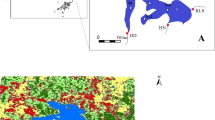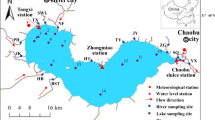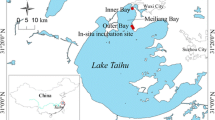Abstract
Significant improvement in wastewater treatment is the most effective way for eutrophication control, especially in semiarid regions. However, its effect on the nutrient status and stoichiometry of the receiving water body has remained poorly considered and understood at broad temporal scales. Taking Guanting Reservoir (GR) in Hebei-Beijing (P. R. China) as an example, we present a study that links a continuous monitoring dataset for GR with corresponding estimates of human-induced nutrient discharges in its watershed from the year 2006 to 2019. We find that current GR belongs to strict P limitation and the faster decrease of TP than TN concentrations and continuous increase of TN/TP mass ratios in GR are attributed to the water restoration investment-induced declining of nutrient loadings. The improved municipal wastewater treatment capacity is mainly responsible for these significant changes, due to the higher removal efficiency of TP than TN in municipal wastewater. Given the potential ecological impact on aquatic biodiversity as well as ecosystem function of changes in TN/TP ratios and higher retention rate of TP (97.4%) compared with TN (93.1%) in GR, our findings highlight that future strategy for water pollution control should not only concentrate on more nutrient reduction efficiencies but attach importance to their stoichiometric balance to reduce the potential risk of phytoplankton blooms and toxin production during the water quality recovery of lakes or reservoirs.








Similar content being viewed by others
Data availability
Data will be made available on request.
Notes
The average exchange rate in 2021 for 1 CNY is 0.155 USD.
References
Bernhardt ES (2013) Cleaner lakes are dirtier lakes. Science 342:205–206
Carpenter SR (2008) Phosphorus control is critical to mitigating eutrophication. P Natl Acad Sci USA 105:11039–11040
Chen S, Chen L, Liu X, Pan Y, Zhou F, Guo J, Huang T, Chen F, Shen Z (2022) Unexpected nitrogen flow and water quality change due to varying atmospheric deposition. J Hydrol 609:127679
Collins SM, Oliver SK, Lapierre JF, Stanley EH, Jones JR, Wagner T, Soranno PA (2017) Lake nutrient stoichiometry is less predictable than nutrient concentrations at regional and sub-continental scales. Ecol Appl 27:1529–1540
Cui S, Shi Y, Groffman PM, Schlesinger WH, Zhu Y-G (2013) Centennial-scale analysis of the creation and fate of reactive nitrogen in China (1910–2010). P Natl Acad Sci USA 110:2052–2057
Dai D, Xu X, Sun M, Hao C, Lv X, Lei K (2020) Decrease of both river flow and quality aggravates water crisis in North China: a typical example of the upper Yongding River watershed. Environ Monit Assess 192:421
Dai D, Lei K, Wang R, Lv X, Hu J, Sun M (2022a) Evaluation of river restoration efforts and a sharp decrease in surface runoff for water quality improvement in North China. Environ Res Lett 17:044028
Dai D, Sun M, Lv X, Hu J, Zhang H, Xu X, Lei K (2022b) Comprehensive assessment of the water environment carrying capacity based on the spatial system dynamics model, a case study of Yongding River Basin in North China. J Clean Prod 344:131137
Dai R, Liu H, Qu J, Ru J, Hou Y (2008) Cyanobacteria and their toxins in Guanting Reservoir of Beijing, China. J Hazard Mater 153:470–477
Elser JJ, Andersen T, Baron JS, Bergström A-K, Jansson M, Kyle M, Nydick KR, Steger L, Hessen DO (2009) Shifts in lake N: P stoichiometry and nutrient limitation driven by atmospheric nitrogen deposition. Science 326:835–837
Elser JJ, Devlin SP, Yu J, Baumann A, Church MJ, Dore JE, Hall RO Jr, Hollar M, Johnson T, Vick-Majors T (2022) Sustained stoichiometric imbalance and its ecological consequences in a large oligotrophic lake. P Natl Acad Sci USA 119:e2202268119
Finlay JC, Small GE, Sterner RW (2013) Human influences on nitrogen removal in lakes. Science 342:247–250
Glibert PM, Maranger R, Sobota DJ, Bouwman L (2014) The Haber Bosch–harmful algal bloom (HB–HAB) link. Environ Res Lett 9:105001
Guildford SJ, Hecky RE (2000) Total nitrogen, total phosphorus, and nutrient limitation in lakes and oceans: is there a common relationship? Limnol Oceanogr 45:1213–1223
He G, Fang H, Bai S, Liu X, Chen M, Bai J (2011) Application of a three-dimensional eutrophication model for the Beijing Guanting Reservoir, China. Ecol Model 222:1491–1501
He W, Chen S, Liu X, Chen J (2008) Water quality monitoring in a slightly-polluted inland water body through remote sensing—Case study of the Guanting Reservoir in Beijing, China. Front Environ Sci En 2:163–171
Hendriks ATWM, Langeveld JG (2017) Rethinking wastewater treatment plant effluent standards: nutrient reduction or nutrient control? Environ Sci Technol 51:4735–4737
Huang J, Zhang Y, Arhonditsis GB, Gao J, Chen Q, Wu N, Dong F, Shi W (2019) How successful are the restoration efforts of China’s lakes and reservoirs? Environ Int 123:96–103
Huang J, Zhang Y, Bing H, Peng J, Dong F, Gao J, Arhonditsis GB (2021) Characterizing the river water quality in China: recent progress and on-going challenges. Water Res: 117309
Ibáñez C, Peñuelas J (2019) Changing nutrients, changing rivers. Science 365:637–638
Jeppesen E, Søndergaard M, Jensen JP, Havens KE, Anneville O, Carvalho L, Coveney MF, Deneke R, Dokulil MT, Foy B (2005) Lake responses to reduced nutrient loading–an analysis of contemporary long-term data from 35 case studies. Freshwater Biol 50:1747–1771
Jiang B, Wong CP, Lu F, Ouyang Z, Wang Y (2014) Drivers of drying on the Yongding River in Beijing. J Hydrol 519:69–79
Jiang M, Nakano S-i (2022) The crucial influence of trophic status on the relative requirement of nitrogen to phosphorus for phytoplankton growth. Water Res 222:118868
Jiang W, Yu J, Li Z, Nakamura T, Yu F, Zhang J (2019) Spatial variation of within-day and between-day chlorophyll a dynamics during summer in Guanting Reservoir, Beijing, China. Appl Ecol Env Res 17:5765–5780
Jiang Y (2009) China’s water scarcity. J Environ Manage 90:3185–3196
Liu X, Sheng H, Jiang S, Yuan Z, Zhang C, Elser JJ (2016) Intensification of phosphorus cycling in China since the 1600s. P Natl Acad Sci USA 113:2609–2614
Liu Y, Engel BA, Flanagan DC, Gitau MW, McMillan SK, Chaubey I, Singh S (2018) Modeling framework for representing long-term effectiveness of best management practices in addressing hydrology and water quality problems: framework development and demonstration using a Bayesian method. J Hydro 560:530–545
Liu Y, Zhu J, Huo R, Tian Z, Yang G, Jin Y (2020) Current situation and problems of rural sewage discharge in Hebei Province. Rural Econ Sci Technol 31:32–36 (in Chinese)
Luo W, Wang T, Lu Y, Giesy JP, Shi Y, Zheng Y, Xing Y, Wu G (2007) Landscape ecology of the Guanting Reservoir, Beijing, China: multivariate and geostatistical analyses of metals in soils. Environ Pollut 146:567–576
Ma T, Sun S, Fu G, Hall JW, Ni Y, He L, Yi J, Zhao N, Du Y, Pei T (2020a) Pollution exacerbates China’s water scarcity and its regional inequality. Nat Commun 11:1–9
Ma T, Zhao N, Ni Y, Yi J, Wilson JP, He L, Du Y, Pei T, Zhou C, Song C, Cheng W (2020b) China’s improving inland surface water quality since 2003. Sci Adv 6: eaau3798
Ma Z, Li L, Ai L (2015) Analysis of spatial and temporal changes of guanting reservoir area from 1978 to 2013. Arid Zone Res 32:428–434 (in Chinese)
Maximillian J, Brusseau M, Glenn E, Matthias A (2019) Pollution and environmental perturbations in the global system, Environmental and pollution science. Elsevier: 457–476
MEE (2002) Ministry of ecology and environment of the People’s Republic of China, Environmental quality standards for surface water, GB 3838–2002, http://www.mee.gov.cn/ywgz/fgbz/bz/bzwb/shjbh/shjzlbz/200206/t20020601_66497.shtml
MEE (2021) Ministry of ecology and environment of Peoples’ Republic of China, Generation and emission coefficient manual for the second Chinese Pollution Source Census
Meng J, Zhou Y, Liu S, Chen S, Wang T (2019) Increasing perfluoroalkyl substances and ecological process from the Yongding Watershed to the Guanting Reservoir in the Olympic host cities. China Environ Int 133:105224
MEP (2002) Ministry of environmental protection of China, technical specifications requirements for monitoring of surface water and waste water. ministry of environmental protection of China, Beijing
Miao S, Jian S, Liu Y, Li C, Guan H, Li K, Wang G, Wang Z (2020) Long-term and longitudinal nutrient stoichiometry changes in oligotrophic cascade reservoirs with trout cage aquaculture. Sci Rep-UK 10:1–10
Morée A, Beusen A, Bouwman A, Willems W (2013) Exploring global nitrogen and phosphorus flows in urban wastes during the twentieth century. Global Biogeoche Cy 27:836–846
OECD (1982) Eutrophication of waters: monitoring, assessment and control, Paris: 1–154
Ongley ED, Zhang Xiaolan Yu, Tao, (2010) Current status of agricultural and rural non-point source pollution assessment in China. Enviro Pollut 158:1159–1168
Paerl HW, Xu H, McCarthy MJ, Zhu G, Qin B, Li Y, Gardner WS (2011) Controlling harmful cyanobacterial blooms in a hyper-eutrophic lake (Lake Taihu, China): the need for a dual nutrient (N & P) management strategy. Water Res 45:1973–1983
Paerl HW, Xu H, Hall NS, Rossignol KL, Joyner AR, Zhu G, Qin B (2015) Nutrient limitation dynamics examined on a multi-annual scale in Lake Taihu, China: implications for controlling eutrophication and harmful algal blooms. J Freshwater Ecol 30:5–24
Paerl HW, Scott JT, McCarthy MJ, Newell SE, Gardner WS, Havens KE, Hoffman DK, Wilhelm SW, Wurtsbaugh WA (2016) It takes two to tango: when and where dual nutrient (N & P) reductions are needed to protect lakes and downstream ecosystems. Environ Sci Technol 50:10805–10813
Palmer M, Ruhi A (2019) Linkages between flow regime, biota, and ecosystem processes: implications for river restoration. Science 365: eaaw2087
Peñuelas J, Poulter B, Sardans J, Ciais P, Van Der Velde M, Bopp L, Boucher O, Godderis Y, Hinsinger P, Llusia J (2013) Human-induced nitrogen–phosphorus imbalances alter natural and managed ecosystems across the globe. Nat Commun 4:1–10
Pernet-Coudrier B, Qi W, Liu H, Müller B, Berg M (2012) Sources and pathways of nutrients in the semi-arid region of Beijing-Tianjin, China. Environ Sci Technol 46:5294–5301
Phillips G, Pitt J-A (2016) A comparison of european freshwater nutrient boundaries: a report to WG ECOSTAT
Posch T, Köster O, Salcher MM, Pernthaler J (2012) Harmful filamentous cyanobacteria favoured by reduced water turnover with lake warming. Nat Clim Change 2:809–813
Qin B, Zhou J, Elser JJ, Gardner WS, Deng J, Brookes JD (2020) Water depth underpins the relative roles and fates of nitrogen and phosphorus in lakes. Environ Sci Technol 54:3191–3198
Schindler DW, Hecky R, Findlay D, Stainton M, Parker B, Paterson M, Beaty K, Lyng M, Kasian S (2008) Eutrophication of lakes cannot be controlled by reducing nitrogen input: results of a 37-year whole-ecosystem experiment. P Natl Acad Sci USA 105:11254–11258
Schindler DW, Carpenter SR, Chapra SC, Hecky RE, Orihel DM (2016) Reducing phosphorus to curb lake eutrophication is a success. Environ Sci Technol 50:8923–8929
Schmadel NM, Harvey JW, Alexander RB, Schwarz GE, Moore RB, Eng K, Gomez-Velez JD, Boyer EW, Scott D (2018) Thresholds of lake and reservoir connectivity in river networks control nitrogen removal. Nat Commun 9:1–10
Stoddard JL, Van Sickle J, Herlihy AT, Brahney J, Paulsen S, Peck DV, Mitchell R, Pollard AI (2016) Continental-scale increase in lake and stream phosphorus: are oligotrophic systems disappearing in the United States? Environ Sci Technol 50:3409–3415
Sun S, Zhou X, Liu H, Jiang Y, Zhou H, Zhang C, Fu G (2021) Unraveling the effect of inter-basin water transfer on reducing water scarcity and its inequality in China. Water Res 194:116931
Tang W, Pei Y, Zheng H, Zhao Y, Shu L, Zhang H (2022) Twenty years of China’s water pollution control: experiences and challenges. Chemosphere 295:133875
Tong Y, Zhang W, Wang X, Couture R-M, Larssen T, Zhao Y, Li J, Liang H, Liu X, Bu X (2017) Decline in Chinese lake phosphorus concentration accompanied by shift in sources since 2006. Nat Geosci 10:507–511
Tong Y, Qiao Z, Wang X, Liu X, Chen G, Zhang W, Dong X, Yan Z, Han W, Wang R (2018) Human activities altered water N: P ratios in the populated regions of China. Chemosphere 210:1070–1081
Tong Y, Wang M, Peñuelas J, Liu X, Paerl HW, Elser JJ, Sardans J, Couture R-M, Larssen T, Hu H (2020) Improvement in municipal wastewater treatment alters lake nitrogen to phosphorus ratios in populated regions. P Natl Acad Sci USA 117:11566–11572
Van de Waal DB, Smith VH, Declerck SA, Stam EC, Elser JJ (2014) Stoichiometric regulation of phytoplankton toxins. Ecol Lett 17:736–742
Van Drecht G, Bouwman A, Harrison J, Knoop J (2009) Global nitrogen and phosphate in urban wastewater for the period 1970 to 2050. Global Biogeochem Cy 23: GB0A03
Wang X, Gong Z, Pu R (2018) Estimation of chlorophyll a content in inland turbidity waters using WorldView-2 imagery: a case study of the Guanting Reservoir, Beijing, China. Environ Monit Assess 190:1–16
Wen Z, Wang R, Li Q, Liu J, Ma X, Xu W, Tang A, Collett JL Jr, Li H, Liu X (2022) Spatiotemporal variations of nitrogen and phosphorus deposition across China. Sci Total Environ 830:154740
Xie Y, Zhang Q, Dzakpasu M, Zheng Y, Tian Y, Jin P, Yang S, Wang X (2021) Towards the formulation of rural sewage discharge standards in China. Sci Total Environ 759:143533
Yan Z, Han W, Peñuelas J, Sardans J, Elser JJ, Du E, Reich PB, Fang J (2016) Phosphorus accumulates faster than nitrogen globally in freshwater ecosystems under anthropogenic impacts. Ecol Lett 19:1237–1246
Yang J, Strokal M, Kroeze C, Wang M, Wang J, Wu Y, Bai Z, Ma L (2019) Nutrient losses to surface waters in Hai He basin: a case study of Guanting reservoir and Baiyangdian lake. Agr Water Manage 213:62–75
Yu G, Jia Y, He N, Zhu J, Chen Z, Wang Q, Piao S, Liu X, He H, Guo X (2019) Stabilization of atmospheric nitrogen deposition in China over the past decade. Nat Geosci 12:424–429
Funding
This work was supported by the National Natural Science Foundation of China [grant number 42207548], the Key Laboratory of Ecological Impacts of Hydraulic-Projects and Restoration of Aquatic Ecosystem of Ministry of Water Resources [grant number KL-MWR-202101], and the National Science and Technology Major Project-Water Pollution Control and Treatment, China [grant number 2018ZX07111002].
Author information
Authors and Affiliations
Contributions
Dan Dai: writing, methodology, software, formal analysis, investigation, writing—original draft. Guoxian Huang: review and editing, data curation, investigation. Kun Lei: investigation, review, and editing. Wenqian Cai: writing, reviewing, and editing. Xianfu Zhao: review and editing. Qingqing Sun, review and editing. Jun Hu: review and editing.
Corresponding author
Ethics declarations
Ethics approval
NA.
Consent to participate
NA.
Consent for publication
NA.
Competing interests
The authors declare no competing interests.
Additional information
Responsible Editor: Thomas Hein
Publisher's note
Springer Nature remains neutral with regard to jurisdictional claims in published maps and institutional affiliations.
Supplementary Information
Below is the link to the electronic supplementary material.
Rights and permissions
Springer Nature or its licensor (e.g. a society or other partner) holds exclusive rights to this article under a publishing agreement with the author(s) or other rightsholder(s); author self-archiving of the accepted manuscript version of this article is solely governed by the terms of such publishing agreement and applicable law.
About this article
Cite this article
Dai, D., Huang, G., Lei, K. et al. Improvement in water pollution control alters nutrient stoichiometry of Guanting Reservoir near Beijing, North China. Environ Sci Pollut Res 30, 45924–45935 (2023). https://doi.org/10.1007/s11356-023-25558-9
Received:
Accepted:
Published:
Issue Date:
DOI: https://doi.org/10.1007/s11356-023-25558-9




